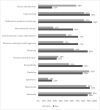Use of Digital Tools in Arbovirus Surveillance: Scoping Review
- PMID: 39556803
- PMCID: PMC11612576
- DOI: 10.2196/57476
Use of Digital Tools in Arbovirus Surveillance: Scoping Review
Abstract
Background: The development of technology and information systems has led to important changes in public health surveillance.
Objective: This scoping review aimed to assess the available evidence and gather information about the use of digital tools for arbovirus (dengue virus [DENV], zika virus [ZIKV], and chikungunya virus [CHIKV]) surveillance.
Methods: The databases used were MEDLINE, SCIELO, LILACS, SCOPUS, Web of Science, and EMBASE. The inclusion criterion was defined as studies that described the use of digital tools in arbovirus surveillance. The exclusion criteria were defined as follows: letters, editorials, reviews, case reports, series of cases, descriptive epidemiological studies, laboratory and vaccine studies, economic evaluation studies, and studies that did not clearly describe the use of digital tools in surveillance. Results were evaluated in the following steps: monitoring of outbreaks or epidemics, tracking of cases, identification of rumors, decision-making by health agencies, communication (cases and bulletins), and dissemination of information to society).
Results: Of the 2227 studies retrieved based on screening by title, abstract, and full-text reading, 68 (3%) studies were included. The most frequent digital tools used in arbovirus surveillance were apps (n=24, 35%) and Twitter, currently called X (n=22, 32%). These were mostly used to support the traditional surveillance system, strengthening aspects such as information timeliness, acceptability, flexibility, monitoring of outbreaks or epidemics, detection and tracking of cases, and simplicity. The use of apps to disseminate information to society (P=.02), communicate (cases and bulletins; P=.01), and simplicity (P=.03) and the use of Twitter to identify rumors (P=.008) were statistically relevant in evaluating scores. This scoping review had some limitations related to the choice of DENV, ZIKV, and CHIKV as arboviruses, due to their clinical and epidemiological importance.
Conclusions: In the contemporary scenario, it is no longer possible to ignore the use of web data or social media as a complementary strategy to health surveillance. However, it is important that efforts be combined to develop new methods that can ensure the quality of information and the adoption of systematic measures to maintain the integrity and reliability of digital tools' data, considering ethical aspects.
Keywords: arbovirus infections; chikungunya fever; dengue; digital tool; public health surveillance; technology; zika virus.
©Carolina Lopes Melo, Larissa Rangel Mageste, Lusiele Guaraldo, Daniela Polessa Paula, Mayumi Duarte Wakimoto. Originally published in the Journal of Medical Internet Research (https://www.jmir.org), 18.11.2024.
Conflict of interest statement
Conflicts of Interest: None declared.
Figures
Similar articles
-
Surveillance of the major pathogenic arboviruses of public health concern in Gabon, Central Africa: increased risk of West Nile virus and dengue virus infections.BMC Infect Dis. 2021 Mar 17;21(1):265. doi: 10.1186/s12879-021-05960-9. BMC Infect Dis. 2021. PMID: 33731022 Free PMC article.
-
Epidemiological profile of arboviruses in two different scenarios: dengue circulation vs. dengue, chikungunya and Zika co-circulation.BMC Infect Dis. 2023 Mar 22;23(1):177. doi: 10.1186/s12879-023-08139-6. BMC Infect Dis. 2023. PMID: 36949383 Free PMC article.
-
Arbovirus investigation in patients from Mato Grosso during Zika and Chikungunya virus introdution in Brazil, 2015-2016.Acta Trop. 2019 Feb;190:395-402. doi: 10.1016/j.actatropica.2018.12.019. Epub 2018 Dec 12. Acta Trop. 2019. PMID: 30552880
-
Advancing arbovirus diagnosis in Brazil: strengthening diagnostic strategies and public health data collection.Braz J Infect Dis. 2024 May-Jun;28(3):103766. doi: 10.1016/j.bjid.2024.103766. Epub 2024 May 25. Braz J Infect Dis. 2024. PMID: 38802065 Free PMC article. Review.
-
Human Urban Arboviruses Can Infect Wild Animals and Jump to Sylvatic Maintenance Cycles in South America.Front Cell Infect Microbiol. 2019 Jul 17;9:259. doi: 10.3389/fcimb.2019.00259. eCollection 2019. Front Cell Infect Microbiol. 2019. PMID: 31380302 Free PMC article. Review.
Cited by
-
Early Warning of Infectious Disease Outbreaks Using Social Media and Digital Data: A Scoping Review.Int J Environ Res Public Health. 2025 Jul 13;22(7):1104. doi: 10.3390/ijerph22071104. Int J Environ Res Public Health. 2025. PMID: 40724171 Free PMC article. Review.
References
-
- Lorenz C, Azevedo TS, Virginio F, Aguiar BS, Chiaravalloti-Neto F, Suesdek L. Impact of environmental factors on neglected emerging arboviral diseases. PLoS Negl Trop Dis. 2017 Sep 27;11(9):e0005959. doi: 10.1371/journal.pntd.0005959. https://dx.plos.org/10.1371/journal.pntd.0005959 PNTD-D-17-00884 - DOI - DOI - PMC - PubMed
-
- Schuffenecker I, Iteman I, Michault A, Murri S, Frangeul L, Vaney M, Lavenir R, Pardigon N, Reynes J, Pettinelli F, Biscornet L, Diancourt L, Michel S, Duquerroy S, Guigon G, Frenkiel M, Bréhin A-C, Cubito N, Desprès P, Kunst F, Rey FA, Zeller H, Brisse S. Genome microevolution of chikungunya viruses causing the Indian Ocean outbreak. PLoS Med. 2006 Jul 23;3(7):e263. doi: 10.1371/journal.pmed.0030263. https://dx.plos.org/10.1371/journal.pmed.0030263 06-PLME-RA-0242R1 - DOI - DOI - PMC - PubMed
-
- Bartholomeeusen K, Daniel M, LaBeaud DA, Gasque P, Peeling RW, Stephenson KE, Ng LFP, Ariën KK. Chikungunya fever. Nat Rev Dis Primers. 2023 Apr 06;9(1):17. doi: 10.1038/s41572-023-00429-2. https://europepmc.org/abstract/MED/37024497 10.1038/s41572-023-00429-2 - DOI - PMC - PubMed
Publication types
MeSH terms
LinkOut - more resources
Full Text Sources


